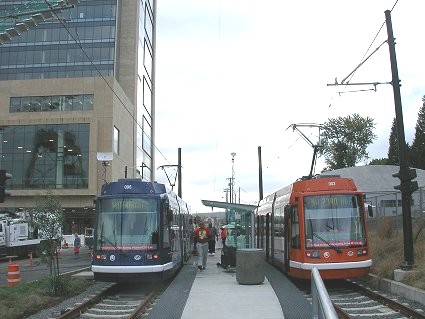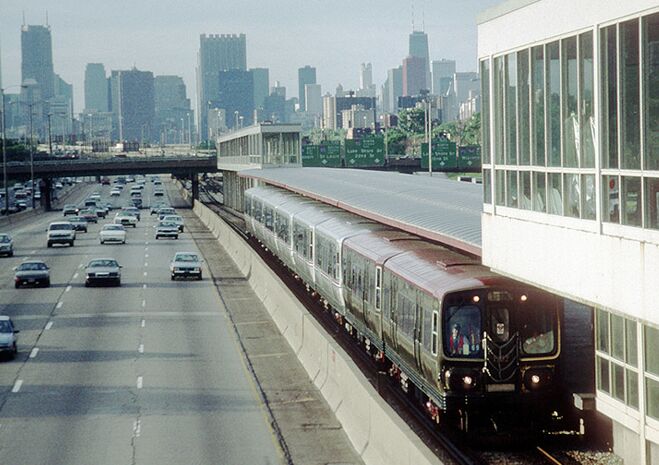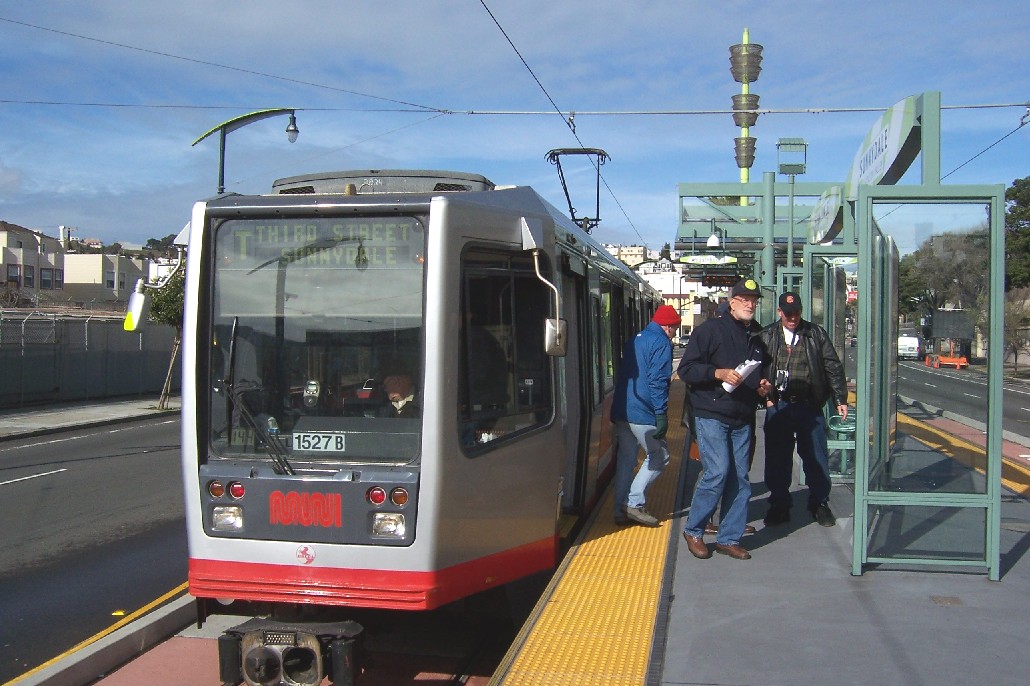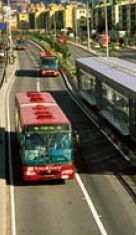This article is a continuation of our series Busting "BRT" Mythology – a discussion intended to examine claims of so-called
"Bus Rapid Transit" by its proponents and to evaluate and contrast these claims with actual experience.
This commentary is the fifth article in this series.
Experts familiar with the Peak Oil crisis are now telling us that petroleum is a
diminishing and increasingly expensive resource and that, for transportation,
conversion to alternative sources of energy – especially electric power
– should be strongly considered.
At the same time, experts familiar with Global Warming are telling us that carbon
emissions are warming Planet Earth, and petroleum-based transportation is a
major culprit – so, again, conversion to more efficient, alternative energy
sources, such as electricity (which is more efficient in moving people and goods,
and can be produced from sustainable sources), is essential.
Within this context, the development of electric transportation, such as urban
electrified rail, is suddenly attracting greater interest. Enthusiasm has been
spreading for electric transportation – especially light rail transit (LRT), both the higher-speed, suburban/interurban type, and even the humble streetcar.
(Ripped out of scores of American cities over four decades ago, the electric
streetcar is now making a spectacular comeback in cities like Portland, Tacoma,
Tampa, Little Rock, San Francisco, Kenosha, and Washington, DC.)
And there's even growing interest in electric buses, such as trolleybuses, which
have been continuing to run in San Francisco, Seattle, Vancouver, Dayton, and Boston, and are at last returning to Philadelphia.
 Portland's electric streetcar system (an adjunct to the region's faster, more extensive MAX interurban LRT system) is example of America's streetcar comeback.
Resounding success of system has led to expansion, much of it now on private right-of-way.
Here, two streetcars serve passengers at the new SW Gibbs station in October 2006.
Portland's electric streetcar system (an adjunct to the region's faster, more extensive MAX interurban LRT system) is example of America's streetcar comeback.
Resounding success of system has led to expansion, much of it now on private right-of-way.
Here, two streetcars serve passengers at the new SW Gibbs station in October 2006.
[Photo: Martin Glastra van Loon]
But this sudden interest in electric rail and trolleybus transit seems to have got
the Road Warriors of the motor vehicle and highway construction industries
seriously bent out of shape and really running scared, leading them to mount a
ferocious and massive public relations blitz, apparently designed to convince us
all that – despite our intuition, and despite the barrage of evidence to the
contrary – petroleum-fueled motor vehicles, including private cars, SUVs,
and buses, are supposedly "greener" than, and superior to, electric rail transit, including LRT.
The collapse of the i-35W freeway bridge in Minneapolis on August 1st has
given further momentum to the effort to derail national enthusiasm for rail transit.
As we've noted in our article
USA: New York Times article prompts criticism with attack on mass transit funding,
a horde of highway and motor vehicle lobbyists and other Road Warriors, plus
assorted shock troopers and ideologues in what transit advocates deride as the "anti-transit jihad", have leaped to
exploit this terrible tragedy by launching a new, even more ferocious and deceptive
campaign to terminate, or at least attenuate, government programs to fund mass
transit, particularly at the federal level – and especially rail transit –
with a goal of re-allocating transit funds into expanded highway financing.
The campaign to promote "BRT" fits comfortably into this basically anti-
transit effort aimed at clobbering rail transit development.
 in recent months, there's been a veritable avalanche of "studies", well-funded
"lecture" tours by "bus rapid transit" ("BRT") promoters, propagandistic "news"
articles generated by compliant journalists, and other efforts to extol the merits of
buses and disparage rail transit.
(Of course, all this comes amidst a step-up in the barrage of more general anti-transit propaganda by familiar road industry hired guns like Wendell Cox and
Randal O'Toole, explaining why accelerated highway expansion and suburban
sprawl are really good for us, and mass transit is an abysmal failure.)
in recent months, there's been a veritable avalanche of "studies", well-funded
"lecture" tours by "bus rapid transit" ("BRT") promoters, propagandistic "news"
articles generated by compliant journalists, and other efforts to extol the merits of
buses and disparage rail transit.
(Of course, all this comes amidst a step-up in the barrage of more general anti-transit propaganda by familiar road industry hired guns like Wendell Cox and
Randal O'Toole, explaining why accelerated highway expansion and suburban
sprawl are really good for us, and mass transit is an abysmal failure.)
[Photo of Los Angles Wilshire Blvd. "BRT": L. Henry]
Perhaps the most visible and strident national honcho of the crusade to
roadblock rail transit development – by hijacking "rapid transit" into a "just
like rail, but cheaper" bus transit swindle – is William Vincent, who heads
the so-called Breakthrough Technologies institute (BTi) – a "BRT"-promotional outfit funded by petroleum industry money.
Vincent (who presents himself as a "transit supporter", but conspires with
national anti-transit gunslingers like Wendell Cox, Randal O'Toole, and Tom
Rubin to hone his anti-rail transit propaganda) has launched a new, more
vigorous effort to push "BRT", traversing the country and helping to plant anti-rail, "amazing bus" news stories with the cooperation of compliant journalists.
Vincent's jihad, and other vicious attacks on rail with efforts to puff up the
capabilities of buses (in many cases, with ridiculous and ludicrous exaggeration),
can be seen in a flurry of recent instances, several of which are described below.
• Tollroads fanatics – An article in
Toll Roads News (3 June) disparages
the capacity advantages of rail transit as "nonsense", claiming that "A lane of
buses can carry more people than a rail line. ... With pavement rather than rails
you can do a lot better than just cars if you're in a corridor like the Blue Line
between O'Hare Airport and downtown Chicago where there's a substantial
demand for transit." The article dismisses rail transit in Chicago and elsewhere
as "a hopelessly inefficient form of transit".
Low-balling rail rapid transit capacity to an absurdly low figure of "3,000
people per peak hour", the tollroaders claim that the capacity of Chicago's rapid transit presently
provided by "a dozen trains ... could be carried comfortably in 100 buses."
And you thought maybe, with Peak Oil and Global Warming, electric rail transit had a bright future?
Not for these guys, who recommend that "Chicago should eject inefficient rail from expressway medians for toll express lanes...."
(NOTE: in refutation of the Toll Roads News claims, it should be pointed out that limitations of busway "BRT" capacity compared with rail have already begun to prompt projects to install LRT or other new rail transit systems
in cities with well-known "BRT" operations, such as Seattle, Ottawa, Curitiba, and Quito.)
 Chicago's Red Line rail rapid transit operation, in median of Dan Ryan Expressway, should be "ejected" and replaced with toll lanes (accommodating "BRT" buses, of course), according to "BRT" and tollroads promoters.
Here, a Red Line train serves Sox/35th station.
Chicago's Red Line rail rapid transit operation, in median of Dan Ryan Expressway, should be "ejected" and replaced with toll lanes (accommodating "BRT" buses, of course), according to "BRT" and tollroads promoters.
Here, a Red Line train serves Sox/35th station.
[Photo: Peter Ehrlich]
• Road Warrior ideologues – The far-right extremists of
the Road Warriors' anti-rail jihad have long since cottoned on to "BRT" as their
fallback alternative to the dreaded rail transit (undoubtedly, in part, because
"BRT" supports the market for motor vehicles, rubber tires, petroleum, and
asphalt, doesn't represent such a substantial and permanent investment as rail,
and doesn't really wow the local public with its success).
Thus the Reason Foundation has chimed in with its own latest diatribe
ferociously attacking rail and extolling the wonders of "BRT".
in an article titled "BRT without Billion-Dollar Exclusive Guideways", and authored by no less than Reason's own Director
of Transportation Studies, Robert W. Poole, Jr., blasts away on the theme that
"The evidence keeps growing that Bus Rapid Transit can provide very high
quality transit service at a lower capital cost than light rail or commuter rail
transit." (Surface Transportation Innovations, issue No. 44, June 2007)
• Target: San Francisco-Bay Area – The anti-rail, pro-"BRT" campaign has long been making a special effort to substitute "BRT" for
potential rail systems in the San Francisco-Bay Area, and this apparently was
one place where the BTi's William Vincent managed to set up a friendly news
piece, built around himself as the "transit expert", rife with the usual deprecations of rail and eulogies of "BRT" accomplishments.
in an article titled "Bus rapid transit a hit worldwide" (4 June), a Tri-Valley Herald reporter praised AC Transit's plans for a new "BRT" service and
claimed extravagantly (and with evidence) that "bus rapid transit is the only type of public
transportation that can earn global warming-fighting credits under Kyoto
Protocols, which seek international cooperation to cut down on greenhouse gases."
(NOTE: A response to similar claims from Vincent and his Breakthrough Technologies outfit with respect to energy consumption and greenhouse gases
is contained in Norman Rolfe's analysis, Reality Check: Breakthrough Technologies institute's Dubious Claims on "Bus Rapid Transit", Electric Rail, and Global Warming.)
 San Francisco area's electric rail services, offering high-quality, virtually pollution-free transit to much of the region, are a special target of the "BRT" anti-rail crusade.
Here, passengers deboard a T-Line train on San Francisco Muni's superb light rail transit system.
San Francisco area's electric rail services, offering high-quality, virtually pollution-free transit to much of the region, are a special target of the "BRT" anti-rail crusade.
Here, passengers deboard a T-Line train on San Francisco Muni's superb light rail transit system.
[Photo: L. Henry]
• Cox News Service "BRT" promotion – Bill Vincent's
national "bash rail, buff up BRT" campaign is the focus of another evidently set-
up news piece – this time a Cox News Service product that appeared,
among a few other places, in the Philadelphia Daily News of 13
May.
The headline of "Better rapid transit? Bus advocates think so" clearly sets the
theme of Buses über alles, and the reporter then spotlights
"Advocates of 'bus rapid transit'" (basically, Vincent) who "say the country is
wasting billions of dollars to build glitzy urban rail systems when people can
travel more cheaply and with less environmental impact by bus."
The article proceeds to retail Vincent's wildly exaggerated costs of rail vs.
lowballed costs of "BRT".
"To be quite blunt about it, there's a lot more money to be made building
rail systems than there is building BRT systems" Vincent is quoted to claim, then
whine, "So you have major engineering and construction firms lobbying cities to
build rail so they can make more money."
Vincent's portrayal of a powerful, ruthless rail transit behemoth trampling over a
poor, neglected motor bus lobby is not only ridiculous beyond absurd (for anyone
familiar with American public transport history and current federal transit policy)
but also quite a stretch, coming from the head of an extremely well-heeled and
influential bus industry advocacy institution.
(NOTE: Further responses to Vincent's claims in this article are contained in the commentary by The Overhead Wire,
Top "Bus Rapid Transit" Lobbyist Lobs Barrage of Baloney Against Rail.)
• Propaganda tours – With the help of bus-industry outfits
such as Vincent's BTi, as well as powerful agencies such as the World Bank and
the Institute for Transportation and Development Policy (ITDP), various Third
World "BRT" promoters have been sponsored on nationwide "lecture" (i.e.,
propaganda) tours with the objective of trying to sideline local rail transit plans by
presenting fanciful tales of "BRT" in their home cities.
One of these is Enrique Peñalosa, former mayor of Bogotá, Colombia, who
honchoed the installation of Bogotá's TransMilenio "BRT" system.
Peñalosa not only has been sponsored on a "lecture" tour across the USA, but
has benefited from puff-media attention such as a U.S.News & World Report
story (2007/03/17) enthusing about Bogotá's "shiny TransMilenio lines", installed
"in less than a decade, by forgoing the expensive glamour of rail for the affordable flexibility of buses."
 However, while Transmilenio is indeed an impressive bus transit facility (see photo, right), what its
promoters soft-pedal is the fact that, to achieve its vaunted passenger-moving capacity, the facility consists of no less than four (4) busway
lanes dedicated to transit in the median of urban arterial roadways.
Allocating that much surface roadway space exclusively to transit was
undoubtedly helped by the extraordinary powers available to Colombia's comparatively authoritarian government.
Furthermore, making it feasible to operate such a system with a labor-intensive
armada of buses is surely helped by a strong ridership drawn from a heavily transit-dependent, low-income population – and dirt-poor Third World wage levels
for the transit workforce probably don't hurt, either.
However, while Transmilenio is indeed an impressive bus transit facility (see photo, right), what its
promoters soft-pedal is the fact that, to achieve its vaunted passenger-moving capacity, the facility consists of no less than four (4) busway
lanes dedicated to transit in the median of urban arterial roadways.
Allocating that much surface roadway space exclusively to transit was
undoubtedly helped by the extraordinary powers available to Colombia's comparatively authoritarian government.
Furthermore, making it feasible to operate such a system with a labor-intensive
armada of buses is surely helped by a strong ridership drawn from a heavily transit-dependent, low-income population – and dirt-poor Third World wage levels
for the transit workforce probably don't hurt, either.
[Photo of Bogotá "BRT": Transit Innovator]
Nevertheless, "BRT" missionaries such as Peñalosa seem to be effective on the
bus industry's tour circuit, mesmerizing receptive audiences and gullible
journalists (who somehow never seem to ask how North American cities would
manage to dedicate four lanes out of any of their major thoroughfares exclusively
to buses, and then attract packed crowds onto those buses averaging just 16 mph).
All signs suggest that this coordinated anti-rail/pro-"BRT"/pro-highways
campaign, by elements within the highway and motor vehicle industries, motor
bus interests, and "BRT" promoters, is only just starting to get revved up.
To adequately educate and inform the public, as well as planners, decisionmakers, and other industry professionals, Light Rail Now! will continue to respond with incisive
analyses of the "BRT" vs. rail transit issue, including our Busting "BRT" Mythology series.
Our primary interest is re-injecting truth and reality back into the urban public transportation planning process.
Listed below are some articles already available online – on
Light Rail Now! and elsewhere – which challenge
much of the propaganda being promulgated by the "BRT" promotion machine.
Misleading Statistics & BRT Promotion
http://theoverheadwire.blogspot.com/2007_05_01_archive.html
Beware of BRT Oversell
http://web.mac.com/msetty/iWeb/Publictransit.us/The%20Publictransit.us%20Blog/5F69236A-5839-450E-A15D-33C355F90AF0.html
Top "Bus Rapid Transit" Lobbyist Lobs Barrage of Baloney Against Rail
http://www.lightrailnow.org/features/f_brt_2007-06a.htm
LA's "Orange Line" Busway – "Just Like Rail, But Cheaper?" A Photo-Report
Reality Check
http://www.lightrailnow.org/facts/fa_brt_2006-10a.htm
Reality Check: Breakthrough Technologies Institute's Dubious Claims on "Bus Rapid Transit", Electric Rail, and Global Warming
http://www.lightrailnow.org/facts/fa_brt_2006-09a.htm
Rail Transit vs. "Bus Rapid Transit": Comparative Success and Potential in Attracting Ridership
http://www.lightrailnow.org/facts/fa_brt_2006-08a.htm
Quality Bus ("BRT") vs. Rail Transit – Fitting the Right Mode to the Application
http://www.lightrailnow.org/features/f_brt_2005-01.htm
"Bus Rapid Transit" or "Quality Bus"? Reality Check
http://www.lightrailnow.org/facts/fa_brt007.htm
Weyrich: Federal Anti-Rail Promotion of "BRT" is "Dead Wrong"
http://www.lightrailnow.org/features/f_brt005.htm
Myth vs. Reality: Has Ottawa "BRT" Provided Light Rail-Type Service at Much Lower Cost?
http://www.lightrailnow.org/myths/m_brt003.htm
Bus "Transitways": A Triumph of Marketing – A Failure of Rigorous Analysis
http://www.lightrailnow.org/facts/fa_brt004.htm
"BRT" - You Can Build it ... But Will They Come?
http://www.lightrailnow.org/facts/fa_brt001.htm
Ottawa's BRT "Transitway": Modern Miracle or Mega-Mirage?
http://www.lightrailnow.org/myths/m_otw001.htm
Curitiba's "Bus Rapid Transit" Operation: A Critical Look Relative to Actual American Transit Experience
http://www.lightrailnow.org/facts/fa_cur02.htm
Research Study: Riders Prefer Light Rail to "Bus Rapid Transit"
http://www.lightrailnow.org/facts/fa_00012.htm
